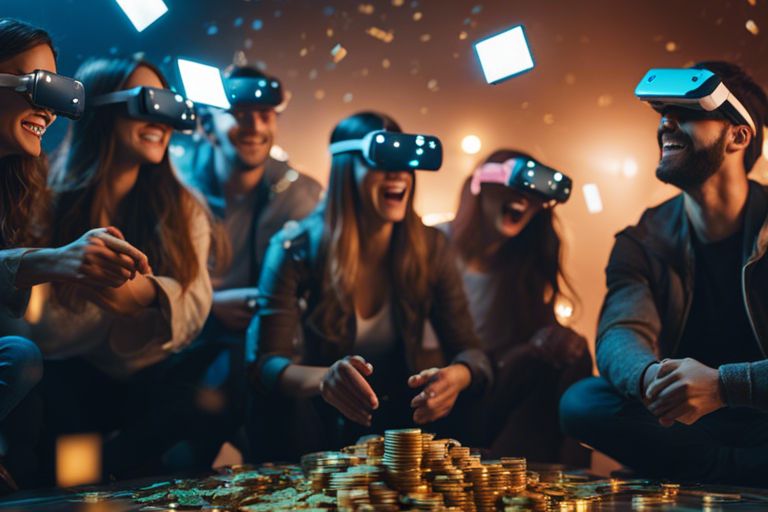Bonuses in the Age of Augmented Reality Gaming

Gaming in the modern era has evolved drastically with the integration of augmented reality technology. This advancement has given rise to a new wave of opportunities and challenges for players seeking bonuses in their gaming experiences. As players navigate through a hybrid virtual and physical world, the concept of bonuses has taken on a whole new meaning.
Understanding Augmented Reality Gaming
Definition and Key Concepts
For those unfamiliar with the concept, augmented reality gaming combines the real world with virtual elements through the use of technology such as smartphones, headsets, or glasses. Players interact with digital objects superimposed on their physical surroundings, creating an immersive and interactive experience. Key concepts in AR gaming include geolocation, 3D mapping, and computer vision, which enable the seamless integration of virtual elements into the real world.
Technological Advances Driving AR Gaming
For the past few years, technological advances have propelled augmented reality gaming into the mainstream. One of the key drivers has been the development of powerful smartphones with advanced sensors and processing capabilities. These devices are important for delivering a smooth and immersive AR experience to users. Additionally, the rise of wearable technology, such as AR glasses and headsets, has further expanded the possibilities for AR gaming, allowing for more seamless integration of virtual elements into the player’s environment.
Driving this technological revolution is the continuous improvement in AR software and algorithms, which enable more accurate tracking of the user’s movements and environment. Furthermore, the integration of artificial intelligence and machine learning technologies has enhanced the realism and interactivity of AR gaming experiences, making them more engaging and immersive than ever before.
The Psychological Appeal of Bonuses in Gaming
Reward Systems and Player Motivation
Rewards have always been a key component in gaming, enticing players to achieve certain goals and providing a sense of accomplishment. In the world of augmented reality gaming, bonuses play a crucial role in enhancing the player experience. Whether it’s unlocking special items, gaining extra points, or receiving exclusive rewards, bonuses can motivate players to continue playing and striving for success.
The Impact of Bonuses on Long-Term Engagement
To truly understand the impact of bonuses on long-term engagement, we must consider the psychological aspect. Bonuses not only provide immediate gratification but also keep players coming back for more. By offering incentives and rewards for continued participation, game developers can successfully retain players and encourage sustained engagement over time.
This loyalty loop created by bonuses can lead to increased player retention and overall enjoyment of the game. Players are more likely to invest time and money into a game that rewards their efforts, ultimately leading to a more successful gaming experience for both the player and the developer.
Types of Bonuses in Augmented Reality Games
After stepping into the exciting world of augmented reality gaming, it’s crucial to understand the different types of bonuses that players can encounter. These bonuses can enhance the gaming experience, provide rewards, and even offer exclusive content. Let’s explore the various types of bonuses in augmented reality games.
In-Game Currency and Items
Items are necessary in augmented reality games as they can help players progress, enhance their gaming experience, and provide a competitive edge. In-game currency is often used to purchase items, unlock features, and customize gameplay. Some games offer daily rewards or challenges that grant players with bonus currency or items, motivating them to play regularly. Items such as power-ups, weapons, and customization options can be acquired through gameplay or in-game purchases, adding depth and complexity to the gaming experience.
Milestones and Achievement Rewards
Any player knows the thrill of reaching a milestone or unlocking an achievement in a game. In augmented reality games, milestone rewards are often given for completing specific tasks, reaching certain levels, or mastering a particular skill. These rewards can include exclusive items, in-game currency, or customization options, incentivizing players to explore the game further and push their limits.
Achievement rewards serve as recognition for players’ accomplishments and dedication to the game. A player may receive special badges, titles, or unique items for completing challenges or excelling in different aspects of the game. These rewards not only signify achievement but also provide a sense of pride and accomplishment for the player.
Exclusive Content and Early Access
Content creators and developers often offer exclusive content and early access to players as a bonus for their loyalty or participation in events. Exclusive content may include rare items, skins, or features not available to regular players, giving a sense of exclusivity and prestige to those who receive them.
For instance, players may gain early access to new levels, characters, or game modes before they are officially released to the public. This gives them a head start in exploring and mastering the new content, as well as a competitive advantage over other players.
Implementing Bonuses in AR Gaming
Balancing Fairness and Accessibility
Fairness: Keep the gameplay fair by ensuring that bonuses do not give an unfair advantage to certain players. It is vital to implement a system where bonuses are accessible to all players regardless of their skill level or financial investment in the game.
Designing Bonuses for Different Player Archetypes
Designing Bonuses for Different Player Archetypes: When creating bonuses in AR gaming, consider the different player archetypes such as competitive players, casual gamers, explorers, social gamers, and achievers. Tailor bonuses to appeal to each type of player to enhance their gaming experience and keep them engaged.
On the whole, designing bonuses that cater to different player archetypes can significantly improve player retention and engagement levels. Knowing what motivates each type of player can help developers create a more personalized gaming experience that appeals to a wider audience.
It
- Competitive players: enjoy bonuses that give them an edge over others in competitive gameplay.
- Casual gamers: prefer bonuses that enhance their overall gaming experience without requiring too much commitment.
- Explorers: are motivated by bonuses that encourage them to discover new locations or hidden gems within the game.
- Social gamers: seek bonuses that foster interactions with other players, such as cooperative challenges or group rewards.
- Achievers: are driven by bonuses that recognize and reward their accomplishments within the game.
Knowing how to cater to each player archetype can lead to increased player satisfaction and loyalty, ultimately benefiting the AR gaming ecosystem. Importantly, understanding the diverse preferences of players can help developers create a more inclusive and engaging gaming experience.
The Business of Bonuses in AR Gaming
Monetization Strategies
To ensure profitability in augmented reality (AR) gaming, developers need to implement effective monetization strategies for bonuses. These strategies often include offering in-app purchases for exclusive bonus content, selling virtual goods or currency, and implementing subscription-based models. By providing desirable bonuses through these channels, developers can generate revenue while enhancing the overall gaming experience for players.
Legal and Ethical Considerations
To uphold legal and ethical standards in bonus implementation, AR gaming companies must adhere to regulations governing gambling, consumer protection, and data privacy. Offering bonuses that involve real money or chance-based rewards could potentially classify as gambling and require proper licensing. Additionally, developers should ensure transparent communication with players regarding bonus mechanics and data collection practices to maintain trust and respect ethical boundaries.
Gaming companies must navigate a complex landscape of regulations to responsibly incorporate bonuses into AR games. Ensuring compliance with laws, as well as respecting player rights and privacy, is imperative to building a sustainable and reputable gaming business in the age of augmented reality.
Future Trends in AR Gaming and Bonuses
Predictive Modeling and Personalization
Despite the rapid advancements in augmented reality (AR) gaming, the future holds even more exciting possibilities for players and developers alike. One of the key trends shaping the landscape of AR gaming is predictive modeling and personalization. This involves utilizing data analytics and machine learning algorithms to anticipate player behavior and preferences, delivering tailored gaming experiences and bonuses.
Integrating Real-World Rewards
For AR gaming to truly revolutionize the industry, integrating real-world rewards is a crucial trend to watch out for in the coming years. By bridging the gap between virtual gameplay and tangible rewards, players can enjoy a more immersive and rewarding gaming experience. Whether it’s discounts at local stores, exclusive merchandise, or even cash prizes, the potential for integrating real-world rewards in AR gaming is limitless.
Any AR game that successfully incorporates real-world rewards has the opportunity to not only enhance player engagement but also drive foot traffic to physical locations. This trend opens up a whole new realm of possibilities for partnerships between game developers and businesses, creating a win-win situation for players and retailers alike.
Predictive modeling in AR gaming can provide valuable insights into player behavior and preferences, allowing developers to offer personalized bonuses and rewards that resonate with individual players. By leveraging predictive analytics, developers can optimize the gaming experience and increase player retention rates.
Conclusion
Hence, as augmented reality gaming continues to become more popular and widespread, the incorporation of bonuses adds an exciting element to the overall gaming experience. These bonuses not only provide additional challenges and rewards for players but also contribute to the immersive nature of the game by blurring the lines between the virtual and physical worlds.
Lastly, bonuses in the age of augmented reality gaming serve as a key feature that enhances gameplay and keeps players engaged. By leveraging the potential of this technology, game developers can continue to push the boundaries of what is possible in gaming and deliver innovative and captivating experiences for players around the world.
FAQs:
What is augmented reality gaming?
Augmented reality gaming combines real-world environments with virtual elements through technology like smartphones or AR glasses, offering an immersive experience.
What types of bonuses are available in AR games?
Bonuses in AR games include in-game currency, milestone rewards, exclusive content, early access to features, and more, enhancing the player experience.
How do bonuses impact player engagement in AR gaming?
Bonuses motivate players to continue playing, fostering long-term engagement by offering rewards, recognition, and a sense of accomplishment for their efforts.
What considerations should developers keep in mind when implementing bonuses?
Developers should ensure fairness and accessibility of bonuses, cater to different player archetypes, and adhere to legal and ethical standards in bonus implementation.
What are the future trends in AR gaming and bonuses?
Future trends include predictive modeling for personalization, integrating real-world rewards, and leveraging data analytics to optimize the gaming experience.
Recommended Posts

Bragg Gaming Expands with Hard Rock Casino
July 3, 2024

How Bonuses Influence Player Loyalty
July 3, 2024

Breaking Down Bonus Rounds in Slot Games
July 3, 2024



